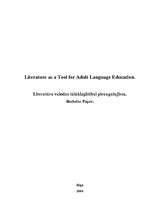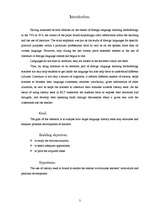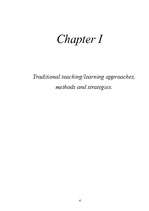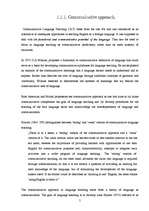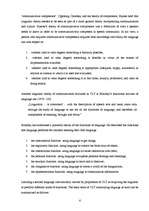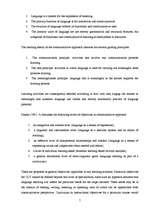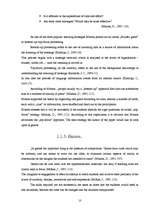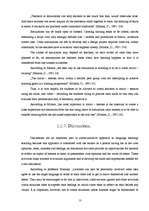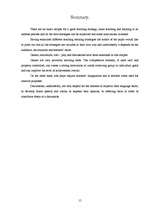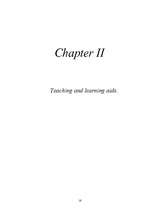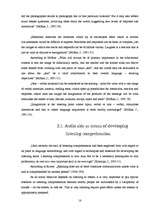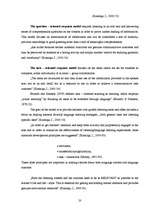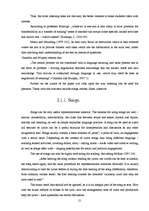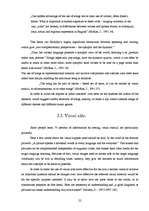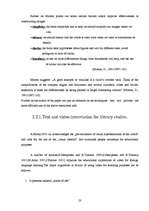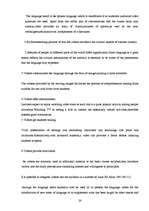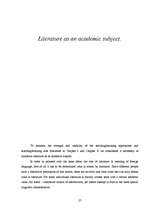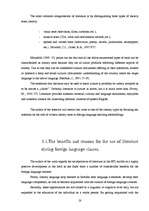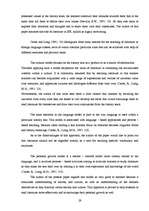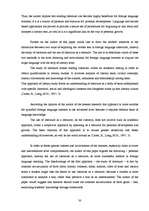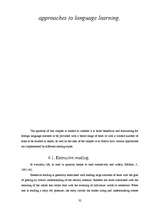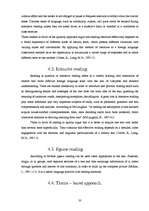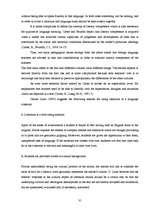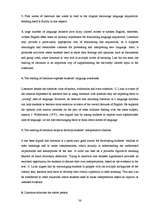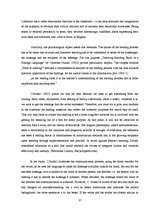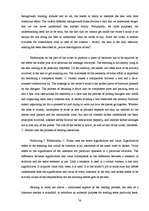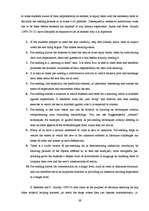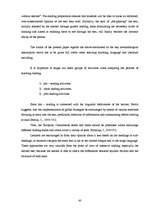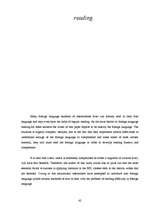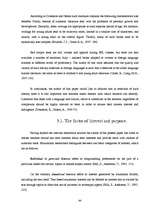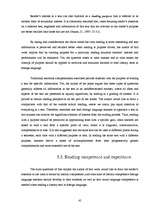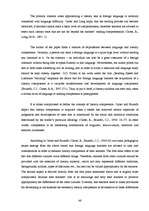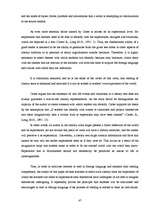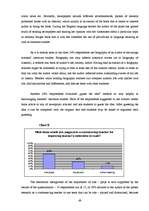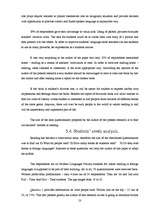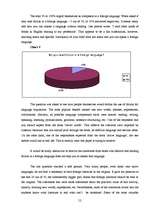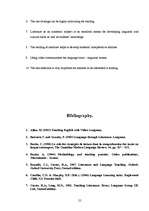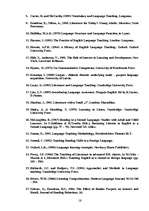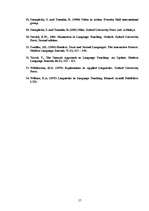-
Literature as a Tool for Adult Language Education
Evaluated!
| Nr. | Chapter | Page. |
| Introduction | 3 | |
| 1.1.1. | Communicative approach | 5 |
| 1.1.3. | Games | 10 |
| 1.1.4. | Evaluating the use of games | 11 |
| 1.1.5. | Role play | 11 |
| 1.1.6. | Simulation | 12 |
| 1.1.7. | Discussions | 13 |
| Summary | 15 | |
| 2.1. | Audio aids as means of developing listening comprehension | 18 |
| 2.1.1. | Songs | 21 |
| 2.2. | Visual aids | 22 |
| 2.2.1. | Text and video interrelation for literary studies | 23 |
| Summary | 26 | |
| 3.1. | The benefits and reasons for the use of literature during foreign language classes | 29 |
| Summary | 31 | |
| Chapter IV | Different reading styles as a means of implementing various approaches to language learning | 32 |
| 4.1. | Extensive reading | 33 |
| 4.2. | Intensive reading | 33 |
| 4.3. | Jigsaw reading | 34 |
| 4.4. | Theme – based approach | 34 |
| 4.5. | The role of reading activities in language learning | 35 |
| Chapter V | Factors building learners’ motivation for reading | 42 |
| 5.1. | The factor of interest and purpose | 45 |
| 5.2. | Reading competence and experience | 46 |
| 5.3. | Questionnaire | 48 |
| 5.4. | Students’ needs analysis | 51 |
| Summary | 53 | |
| Conclusion | 54 | |
| Theses | 55 | |
| Bibliography | 56 |
Communicative approach.
Communicative Language Teaching (CLT) dates from the late 60s and was introduced as an alternative to inadequate approaches to teaching English as a foreign language. It was supposed to deal with the functional and communicative potential of the language. They saw the need to focus in language teaching on communicative proficiency rather than on mere mastery of structures.
In 1972 D.A.Wilkins, proposed a functional or communicative definition of language that could serve as a basis for developing communicative syllabuses for language teaching. He accomplished an analysis of the communicative meanings that a language learner needs to understand and to express. Rather than describe the core of language through traditional concepts of grammar and vocabulary, Wilkins attemted to demonstrate the systems of meanings that lay behind the communicative uses of language.
Both American and British proponents see communicative approach as one that aims to (a) make communicative competence the goal of language teaching and (b) develop procedures for the teaching of the four language skills that acknowledge the interdependence of language and communication.
Howatt (1984: 279) distinguishes between ‘strong’ and ‘weak’ version of communicative language teaching:
„There is in a sense, a ‘strong’ version of the communicative approach and a ‘weak’ version of it. The weak version which has become more or less standart practice in the last ten years, stresses the importance of providing learners with opportunities to use their English for communicative purposes and, characteristically, attempts to integrate such activities into a wider program of language teaching... The ‘strong’ version of communicative teaching, on the other hand, advances the claim that language is acquired through communication, so that it is not merely a question of activating an existing but inert knowledge of the language, but of stimulating the development of the language system itself. If the former could be described as ‘learning to use’ English, the letter entails ‘using English to learn it.”
The communicative approach in language teaching starts from a theory of language as communication. The goal of language teaching is to develop what Hymes (1972) referred to as ‘communicative competence’. Opposing Chomsky and his theory of competence, Hymes held that linguistic theory needed to be seen as part of a more general theory incorporating communication and culture. Hymes’s theory of communicative competence was a definition of what a speaker needs to know in order to be communicatively competent in speech community. In his view, a person who acquires communicative competence acquires both knowledge and ability for language use with respect to
1. whether (and to what degree) something is formally possible;
2. whether (and to what degree) something is feasible in virtue of the means of implementation available;
3. whether (and to what degree) something is appropriate (adequate, happy, successful) in relation to context in which it is used and evaluated;
4. whether (and to what degree) something is in fact done, actually performed, and what its doing entails.
Another linguistic theory of communication favoured in CLT is Holliday’s functional account of language use (1970: 145).
„Linguistics ... is concerned ... with the description of speech acts and texts, since only through the study of language in use are all the functions of language, and therefore, all components of meaning, brought into focus.”
Holliday has elaborated a powerful theory of the functions of language. He described the functions that language performs for children learning their first language:
1. the instrumental function: using language to get things;
2. the regulatory function: using language to control the behaviour of others;
3. the interactional function: using language to create interaction with other;
4. the personal function: using language to express personal feelings and meanings;
5. the heuristic function: using language to learn and to discover;
6. the imaginative function: using language to create a world of the imagination;
7. the representational function: using language to communicate information.
Learning a second language was similarly viewed by proponents of CLT as acquiring the linguistic to perform different kinds of functions. The basic tents of CLT concerning language as such can be summarized as follows:
1. Language is a system for the expression of meaning.
2. The primary function of language is for interaction and communication.
3. The structure of language reflects its functional and communicative uses.
4. The primary units of language are not merely grammatical and structural features, but categories of funxtional and communicative meaning as exemplified in discourse.
The learning theory of the communicative approach likewise has several guiding principles:
1. The communication principle: activities that involve real communication promote learning.
2. The task principle: activities in which language is used for carrying out meaningful tasks promote learning.
3. The meaningfulness principle: language that is meaningful to the learner supports the learning process.
…
Traditional teaching/learning approaches, methods and strategies; Teaching and learning aids; Literature as an academic subject; Different reading styles as a means of implementing various approaches to language learning; Factors building learners’ motivation for reading etc.

